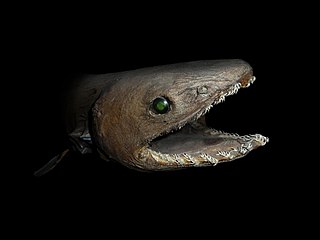
The frilled shark and the southern African frilled shark are the two extant species of shark in the family Chlamydoselachidae. The frilled shark is considered a living fossil, because of its primitive, anguilliform (eel-like) physical traits, such as a dark-brown color, amphistyly, and a 2.0 m (6.6 ft)–long body, which has dorsal, pelvic, and anal fins located towards the tail. The common name, frilled shark, derives from the fringed appearance of the six pairs of gill slits at the shark's throat.

The African angelshark is an angelshark of the family Squatinidae.
Upogebia capensis, or Cape mud shrimp, is a mud shrimp of the family Upogebiidae. It is endemic to the Atlantic and Indian Ocean coasts of southern Africa and occurs from Namibia (Luderitz) to Mozambique.

The Mediterranean mussel is a species of bivalve, a marine mollusc in the family Mytilidae. It is an invasive species in many parts of the world, and also an object of aquaculture.
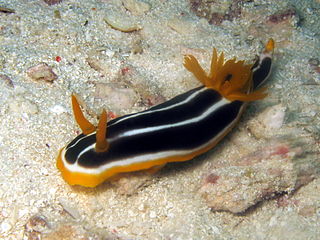
Chromodoris africana, or four-coloured nudibranch, is a species of colourful sea slug, a dorid nudibranch, a marine gastropod mollusc in the family Chromodorididae.

The hairy chiton is a species of chiton in the family Chaetopleuridae. It is a marine mollusc.
The orange hairy chiton, Chaetopleura pertusa, is a species of chitons in the family Chaetopleuridae. It is a marine mollusc. It is endemic to South Africa.

Burnupena papyracea, common name the papery burnupena, is a species of sea snail, a marine gastropod mollusk in the family Buccinidae, the true whelks.
Afrolittorina africana is a species of sea snail, a marine gastropod mollusk in the family Littorinidae, the winkles or periwinkles.
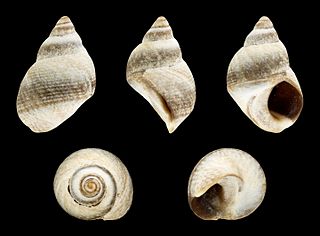
Afrolittorina knysnaensis, common name the southern periwinkle, is a species of sea snail, a marine gastropod mollusk in the family Littorinidae, the winkles or periwinkles.
Clinus heterodon, the westcoast klipfish, is a species of clinid that occurs in subtropical waters of the Atlantic Ocean from Namibia to South Africa where it is a denizen of tide pools. This species can reach a maximum length of 13 centimetres (5.1 in) TL. This species feeds on marine invertebrates.
Aulacomya atra, called also the Magellan mussel or the ribbed mussel, is a southern species of edible saltwater mussel, a marine bivalve mollusk in the family Mytilidae, the true mussels. Note that the common name ribbed mussel is also used of the Northern Hemisphere mussel Geukensia demissa.
Chiromantes eulimene is a species of crab found in the mangrove swamps of south-eastern Africa.
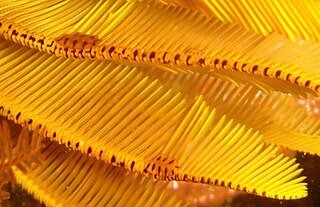
Myzostoma fuscomaculatum, the crinoid worm, is a species of marine worm in the family Myzostomida.
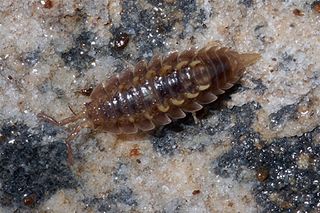
Deto echinata, the horned isopod, is a species of air-breathing isopod, or woodlouse, in the family Detonidae. It inhabits seashores in southern Africa and on some oceanic islands.
Chrysaora fulgida, the Benguela compass jelly, is a species of jellyfish in the family Pelagiidae. Found in the southeastern Atlantic Ocean along the western coast of South Africa, its taxonomy has historically caused considerable confusion. Like other sea nettles, its sting is painful, but not generally dangerous unless there is an allergic reaction to the venom.
Chrysaora africana, the purple compass jelly, is a species of jellyfish from the family Pelagiidae. Found in the southeastern Atlantic Ocean from Gabon to the western coast of South Africa, its taxonomy has historically caused considerable confusion. Like other sea nettles, its sting is painful, but not generally dangerous unless there is an allergic reaction to the venom.

Laminaria pallida, the split-fan kelp, is a species of large brown seaweed of the class Phaeophyceae found from Danger Point on the south coast of South Africa to Port Nolloth, Tristan da Cunha and Gough islands in the Atlantic and Île Saint-Paul in the Indian Ocean.

The Marine biodiversity of South Africa is the variety of living organisms that live in the seas off the coast of South Africa. It includes genetic, species and ecosystems biodiversity in a range of habitats spread over a range of ecologically varied regions, influenced by the geomorphology of the seabed and circulation of major and local water masses, which distribute both living organisms and nutrients in complex and time-variable patterns.










